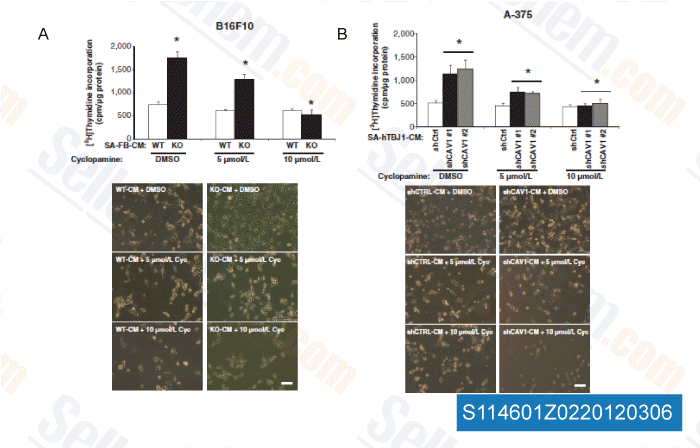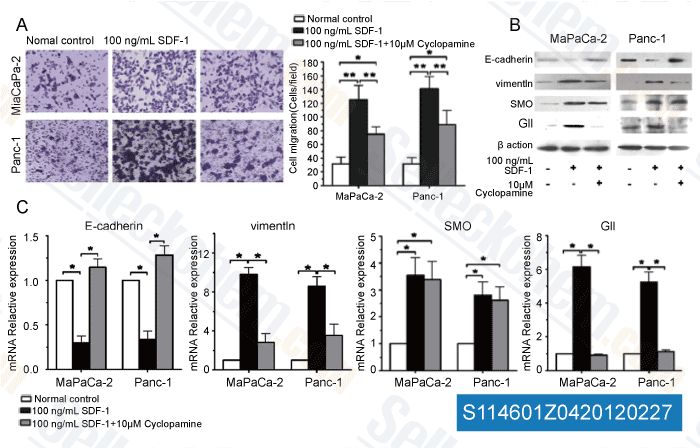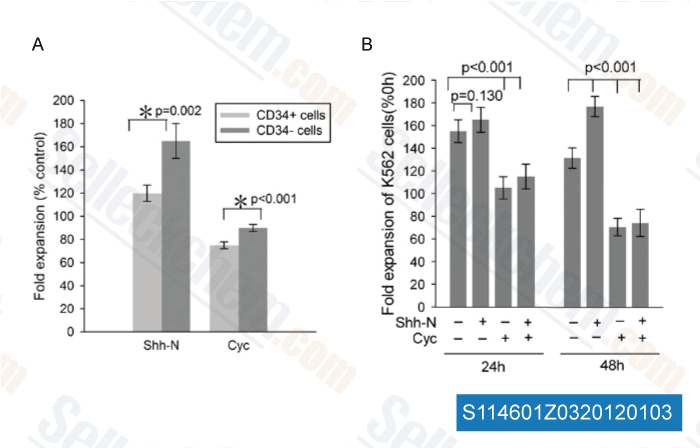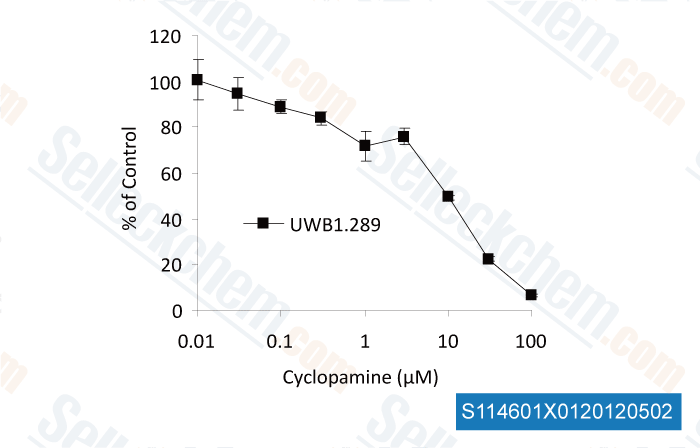|
Toll Free: (877) 796-6397 -- USA and Canada only -- |
Fax: +1-832-582-8590 Orders: +1-832-582-8158 |
Tech Support: +1-832-582-8158 Ext:3 Please provide your Order Number in the email. |
Technical Data
| Formula | C27H41NO2 |
|||
| Molecular Weight | 411.62 | CAS No. | 4449-51-8 | |
| Solubility (25°C)* | In vitro | Ethanol | 15 mg/mL (36.44 mM) | |
| DMSO | 6.25 mg/mL (15.18 mM) | |||
| Water | Insoluble | |||
|
* <1 mg/ml means slightly soluble or insoluble. * Please note that Selleck tests the solubility of all compounds in-house, and the actual solubility may differ slightly from published values. This is normal and is due to slight batch-to-batch variations. * Room temperature shipping (Stability testing shows this product can be shipped without any cooling measures.) |
||||
Preparing Stock Solutions
Biological Activity
| Description | Cyclopamine (11-deoxojervine) is a specific Hedgehog (Hh) signaling pathway antagonist of Smoothened (Smo) with IC50 of 46 nM in TM3Hh12 cells. | ||
|---|---|---|---|
| Targets |
|
||
| In vitro | Cyclopamine inhibits the Hedgehog signaling pathway with an IC50 of 46 nM, and blocks the activity of human Smo receptor expressed in CHO-K1 cells in [3H]Hh-Ag binding assay with an IC50 of 280 nM. [1] Cyclopamine significantly inhibits Hedgehog pathway activity in a dose-dependent manner in gut-derived tumor cell lines expressing Patched (PTCH) mRNA, and induces growth inhibition of those tumor cell lines by 75-95% at the concentration of 3 μM, but ineffective towards the colon tumor cells without PTCH mRNA expression, suggesting the effects of Cyclopamine treatment are Hedgehog pathway related rather than generally cytotoxic. [2] By blocking Hedgehog signaling through direct interaction with Smo, Cyclopamine (10 μM) inhibits the proliferation of SMOhigh Cyclopamine-responsive cell lines L3.6sl and Panc 05.04 by 75-80%, and increases the apoptosis by 2.5- to 3.5-fold, without affecting the BxPC3-SMOlow cell line. [3] Cyclopamine treatment significantly decreases of Snail mRNA and increasea E-cadherin transcripts in the E3LZ10.7 cell line. Independent of inhibition of cell growth, Cyclopamine treatment significantly inhibits the invasive phenotype of Hedgehog-dependent L3.6pl cells, causing a >500-fold reduction in the number of transmigrating cells, but not that of the Hedgehog-independent cell line Panc-1. [4] | ||
| In vivo | Administration of Cyclopamine at dose of 50 mg/kg/day for 22 days eradicates the HUCCT1 xenografts in mice with no obvious adverse effects. [2] Cyclopamine treatment at dose of 1.2 mg for 7 days induces significant apoptosis of tumor cells and decreases the tumor mass by 50-60% in Panc 05.04- and L3.6sl-derived tumors, respectively, but not in the BxPC3-SMOlow tumors. [3] Administration of Cyclopamine alone profoundly inhibits tumor metastases in xenografts of E3LZ10.7 and L3.6pl, and completely abrogates metastases when in combination of gemcitabine. [4] |
Protocol (from reference)
| Kinase Assay:[1] |
|
|---|---|
| Cell Assay:[2] |
|
| Animal Study:[2] |
|
References
Customer Product Validation

-
Data from [Cancer Res, 2012, 72, 2262-74]

-
Data from [Cancer Lett, 2012, 322, 169-176]

-
Data from [Exp Hematol, 2012, 40, 418-27]

-
, , Dr. Yong-Weon Yi from Georgetown University Medical Center
Selleck's Cyclopamine has been cited by 141 publications
| Phosphorylation of human glioma-associated oncogene 1 on Ser937 regulates Sonic Hedgehog signaling in medulloblastoma [ Nat Commun, 2024, 15(1):987] | PubMed: 38307877 |
| PTCH1-mutant human cerebellar organoids exhibit altered neural development and recapitulate early medulloblastoma tumorigenesis [ Dis Model Mech, 2024, 17(2)dmm050323] | PubMed: 38411252 |
| Human osteoarthritic chondrocytes up-regulate the expression of osteoprotegerin in osteoblasts via the Indian hedgehog signaling pathway [ Chinese Journal of Tissue Engineering Research, 2024, Vol. 28 ›› Issue (26): 4194-4201.] | PubMed: none |
| Hedgehog receptors exert immune-surveillance roles in the epidermis across species [ Cell Rep, 2023, 42(8):112929] | PubMed: 37527037 |
| Sonic Hedgehog and WNT Signaling Regulate a Positive Feedback Loop Between Intestinal Epithelial and Stromal Cells to Promote Epithelial Regeneration [ Cell Mol Gastroenterol Hepatol, 2023, 16(4):607-642] | PubMed: 37481204 |
| Sonic Hedgehog and WNT Signaling Regulate a Positive Feedback Loop Between Intestinal Epithelial and Stromal Cells to Promote Epithelial Regeneration [ Cell Mol Gastroenterol Hepatol, 2023, 16(4):607-642] | PubMed: 37481204 |
| Proteomic analysis across patient iPSC-based models and human post-mortem hippocampal tissue reveals early cellular dysfunction and progression of Alzheimer's disease pathogenesis [ Acta Neuropathol Commun, 2023, 11(1):150] | PubMed: 37715247 |
| Proteomic analysis across patient iPSC-based models and human post-mortem hippocampal tissue reveals early cellular dysfunction and progression of Alzheimer's disease pathogenesis [ Acta Neuropathol Commun, 2023, 11(1):150] | PubMed: 37715247 |
| Triptolide inhibits epithelial ovarian tumor growth by blocking the hedgehog/Gli pathway [ Aging (Albany NY), 2023, 10.18632/aging.205110] | PubMed: 37851362 |
| Signaling Switching from Hedgehog-GLI to MAPK Signaling Potentially Serves as a Compensatory Mechanism in Melanoma Cell Lines Resistant to GANT-61 [ Biomedicines, 2023, 11(5)1353] | PubMed: 37239024 |
RETURN POLICY
Selleck Chemical’s Unconditional Return Policy ensures a smooth online shopping experience for our customers. If you are in any way unsatisfied with your purchase, you may return any item(s) within 7 days of receiving it. In the event of product quality issues, either protocol related or product related problems, you may return any item(s) within 365 days from the original purchase date. Please follow the instructions below when returning products.
SHIPPING AND STORAGE
Selleck products are transported at room temperature. If you receive the product at room temperature, please rest assured, the Selleck Quality Inspection Department has conducted experiments to verify that the normal temperature placement of one month will not affect the biological activity of powder products. After collecting, please store the product according to the requirements described in the datasheet. Most Selleck products are stable under the recommended conditions.
NOT FOR HUMAN, VETERINARY DIAGNOSTIC OR THERAPEUTIC USE.
